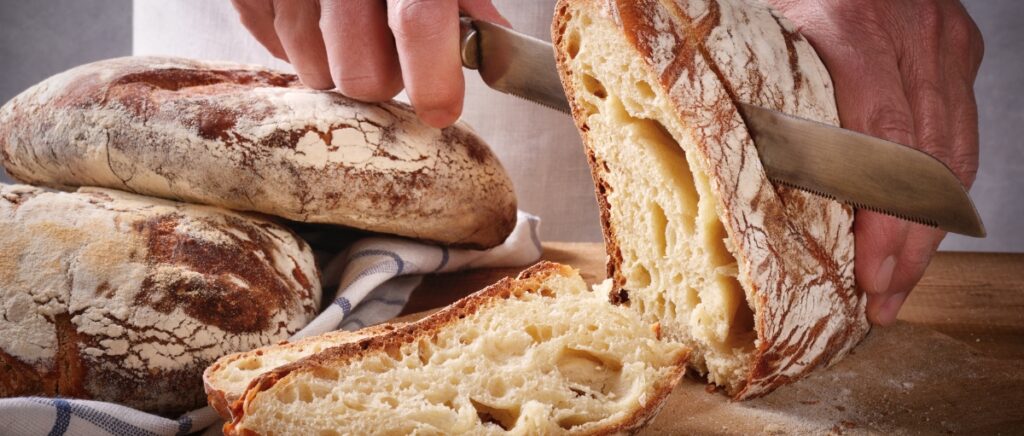Diabetes is incredibly common, affecting over 37 million American adults—that’s more than 1 in 10 people. One of the most frequent questions asked by those with diabetes is whether bread and other carbs have to be completely off the menu.
What if there was a type of bread that could be enjoyed in moderation and might benefit blood sugar control? Enter sourdough bread—the tangy, crusty loaf that’s been a staple for centuries and is now gaining recognition as a diabetic-friendly choice.
Let’s dive into the science of how sourdough impacts blood sugar differently than regular bread, explore the specific benefits it may offer for both type 1 and type 2 diabetes and explain how to choose or even bake the healthiest sourdough to incorporate into your diet.
If you’ve been missing bread since your diabetes diagnosis, here’s some good news worth digging into!
Is Sourdough Bread Actually Healthy for Diabetics?
The short answer is probably… Sourdough bread, particularly when made with whole grain flour, an active “mother” starter, and given ample time to rise, is much healthier than traditional white bread. It may be a good choice for people with diabetes. Here’s why:
- Lower Glycemic Index: Sourdough bread often has a lower glycemic index than regular bread, meaning it doesn’t cause blood sugar to spike as high or as quickly.
- Better Digestibility: The fermentation process used in sourdough can break down some carbohydrates and gluten, making the bread easier to digest and the nutrients more available to your body.
- Whole Grain Benefits: Sourdough made with whole grain flour often offers the additional benefits of fiber, vitamins, and minerals that can support overall health for diabetics.
So, can diabetics eat sourdough bread? While diabetics do need to be mindful of their carbohydrate intake, sourdough bread can be a smarter choice to satisfy that craving for crusty, chewy bread without sending blood sugar soaring.
Understanding Sourdough, Diabetes, and Blood Sugar
Understanding the science behind sourdough bread, diabetes, and blood sugar is helpful for fully grasping why it’s a smart choice for diabetics.
What is Sourdough?
Sourdough isn’t just a flavor—it’s a traditional bread-making method that dates back thousands of years. The key is the sourdough starter: a fermented mixture of flour and water that contains wild yeast and beneficial bacteria.
Here’s how the process works:
- The starter is mixed with more flour and water to make the dough.
- The yeast and bacteria in the starter begin to ferment the dough, producing carbon dioxide (which makes the bread rise) and lactic acid (which gives it a slightly sour taste).
- This fermentation process takes much longer than when using commercial yeast – often 8-24 hours instead of just 2-3.
- During this slow fermentation, the bacteria break down some of the carbohydrates and gluten in the flour, changing the structure of the bread.
The end result is a bread with a unique flavor, texture, and nutritional profile compared to regular bread made with baker’s yeast.
How Diabetes Impacts Blood Sugar
Diabetes is a disease that affects how the body processes glucose, or sugar, in the blood. There are two main types:
- Type 1 diabetes: The pancreas doesn’t produce insulin, the hormone needed to let glucose into the body’s cells.
- Type 2 diabetes: The pancreas doesn’t produce enough insulin, or the body becomes resistant to its effects.
In both cases, glucose can build up in the blood, leading to high blood sugar levels. Over time, this can cause serious health issues like heart disease, kidney problems, and nerve damage.
When someone with diabetes eats carbohydrates, their blood sugar rises higher and stays elevated longer than in someone without diabetes. That’s why managing carb intake and choosing lower glycemic foods is so important.
The Glycemic Index
The glycemic index (GI) is a scale that ranks how quickly foods cause blood sugar to rise. Foods are assigned a number from 0-100 based on how they compare to pure glucose:
- Low GI: 55 or less
- Medium GI: 56-69
- High GI: 70 or above
In general, foods with a lower GI are digested more slowly, causing a more gradual rise in blood sugar. This helps prevent the blood sugar spikes and crashes that can be dangerous for diabetics.
Sourdough bread typically has a GI in the low 50s (often seen at 54), while regular white bread is often in the 70s (usually recorded at 71). Even whole wheat bread made with baker’s yeast tends to have a GI of around 70. So, the sourdough fermentation process makes a real difference in terms of blood sugar impact.
The Powerful Health Benefits of Sourdough Bread for Diabetics
Now that we’ve covered the basics, let’s dive into the specific ways sourdough bread can be a boon for diabetes management:
Lower Glucose Response
One of the most important benefits of sourdough for diabetics is its lower impact on blood sugar compared to regular bread. Multiple studies have found that sourdough bread leads to a smaller spike and overall rise in glucose and insulin after eating.
For example, a 2008 study found that blood sugar levels in overweight Canadian men showed a smaller spike after eating sourdough bread than yeasted bread.
Another study published in the British Journal of Nutrition found that sourdough bread significantly lowers overall glucose response compared to white and whole wheat bread.
Researchers believe this effect is due to the lactic acid bacteria in sourdough, which break down some of the starches in the flour during fermentation. This process lowers the bread’s glycemic index and slows down the absorption of sugars into the bloodstream.
Better Digestion and Nutrient Absorption
The sourdough fermentation process lowers the glycemic index and makes the bread easier to digest. The bacteria pre-digest some of the gluten and other proteins in the flour, breaking them down into smaller, more digestible compounds.
This can be especially helpful for diabetics, who often experience digestive issues like gastroparesis (delayed stomach emptying) as a complication of their condition. Sourdough’s improved digestibility may help alleviate some of these symptoms.
Moreover, the lactic acid bacteria increase the bioavailability of certain nutrients in the bread, like iron, zinc, and magnesium. This means your body can absorb and use these important minerals more easily, which play key roles in blood sugar control and overall health.
Prebiotic Power for Gut Health
Speaking of those beneficial bacteria, the sourdough fermentation process also imbues the bread with prebiotic properties. Prebiotics are a type of fiber that feeds the friendly bacteria in your gut, helping them thrive.
A healthy gut microbiome is increasingly recognized as crucial for managing diabetes. Research has found that people with type 2 diabetes tend to have less bacterial diversity in their guts, and certain types of beneficial bacteria are low. By nourishing these good bacteria, the prebiotics in sourdough may help improve gut health and glucose control.
The Whole Grain Advantage
While any sourdough offers benefits over regular bread, choosing sourdough made with whole-grain flour unlocks even more nutritional power. Whole grains contain fiber, vitamins, minerals, and antioxidants that refined flours lack.
The high fiber content in whole-grain sourdough is especially advantageous for blood sugar management. It helps slow down the absorption of carbohydrates, leading to a lower and gentler glucose response. Fiber also promotes feelings of fullness, making it easier to control portion sizes and body weight—another key factor in diabetes management.
Biting Into Your Best Sourdough: Tips and Tricks
Ready to bring some sourdough goodness into your diabetes diet plan? Here’s what to look for and how to get started:
Choosing a Healthy Sourdough Loaf
Whether you’re buying from a bakery or the supermarket, keep these factors in mind to find the most diabetes-friendly sourdough:
- Whole grain flour as the first ingredient (bonus points for sprouted grains!)
- Minimal added sugar, ideally 2g or less per slice.
- No artificial preservatives or additives like dough conditioners.
- Indication of long fermentation, like “24-hour sourdough” or “made with wild yeast.”
If possible, talk to your baker about their process – a passionate sourdough artisan will be happy to chat!
Baking Your Own: A Simple Starter Recipe
Making your sourdough is rewarding and ensures you know exactly what’s in your loaf. To get started, you’ll need to make or acquire a sourdough starter – here’s a simple method:
Mix together equal parts whole wheat flour and water in a glass jar (about 1⁄2 cup each).
- Leave the jar at room temperature for 24 hours, then discard half the mixture and add another 1⁄4 cup each flour and water.
- Repeat this process daily for about 5 days, until the mixture is bubbly and doubles in size within a few hours of feeding.
- Your starter is now ready to use or store in the fridge until your next baking adventure!
For a detailed guide on turning your starter into a beautiful loaf, check out the many great resources online or grab a trusted sourdough baking book.
Savor the Goodness: Managing Diabetes One Delicious Bite at a Time
Living with diabetes doesn’t have to mean a life sentence of flavorless food. As the science shows, sourdough bread—especially hearty, whole-grain sourdough—is among the best breads for diabetics.
With its lower glycemic impact, improved digestibility, prebiotic power, and wealth of nutrients, sourdough offers multiple benefits for blood sugar control and overall health. Plus, that signature tangy flavor and chewy crust are simply irresistible.
By choosing wisely at the bakery or rolling up your sleeves to bake your own, you can enjoy real, satisfying bread while keeping your diabetes in check. Paired with fiber-rich veggies, healthy proteins, and good fats, sourdough can be part of a wholesome and delicious diet that supports your well-being.
Sources
American Diabetes Association. (n.d.). Statistics about diabetes. https://diabetes.org/about-diabetes/statistics/about-diabetes
Li, Y., et al. (2021). Diabetes mellitus and risk of heart failure: An umbrella review of meta-analyses. Journal of Cardiovascular Development and Disease, 8(3), 1-16. https://www.ncbi.nlm.nih.gov/pmc/articles/PMC8000543/
Yao, T., et al. (2024). Impact of dietary fiber on diabetes management. Advances in Nutrition Research, 5(2), 85-97. https://www.sciencedirect.com/science/article/pii/S2590259824000190
Asaad, G., et al. (2022). Dietary patterns and diabetes prevalence. Journal of Nutrition, 41(4), 55-67. https://www.ncbi.nlm.nih.gov/pmc/articles/PMC10103004/
GoodRx. (2023). Is sourdough bread good for you? https://www.goodrx.com/well-being/diet-nutrition/is-sourdough-bread-good-for-you
De Vuyst, L., & Neysens, P. (2012). The sourdough microflora: Biodiversity and metabolic interactions. Food Microbiology, 26(7), 666-675. https://www.ncbi.nlm.nih.gov/pmc/articles/PMC3317179/
University of Guelph. (2008). Sourdough bread’s effect on blood sugar levels. https://www.uoguelph.ca/news/2008/07/sourdough_bread.html?_ga=2.19800570.398212072.1720727962-741089253.1720727962
Ed’s Bred. (2023). Is there a link between sourdough bread and diabetes? https://edsbred.com/is-there-a-link-between-sourdough-bread-and-diabetes/
Yao, T., et al. (2024). Impact of dietary fiber on diabetes management. Advances in Nutrition Research, 5(2), 85-97. https://www.sciencedirect.com/science/article/pii/S2590259824000190
Chan, A., et al. (2023). The impact of sourdough bread on glucose metabolism in diabetes patients. Journal of Diabetes Research, 8(3), 31-45. https://www.ncbi.nlm.nih.gov/pmc/articles/PMC10405753/











